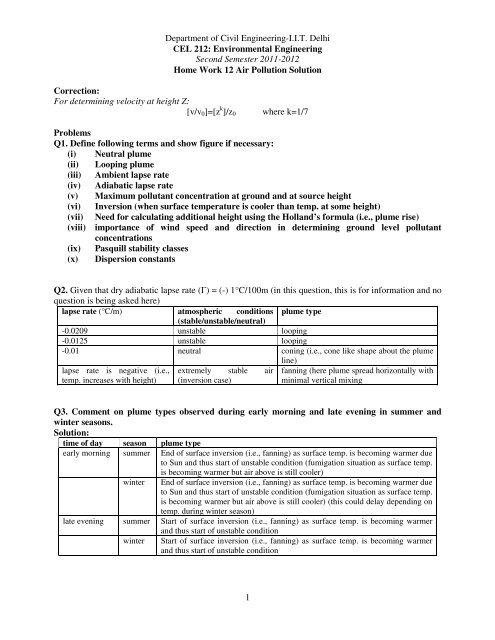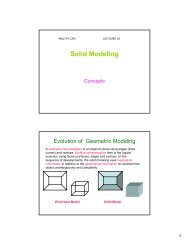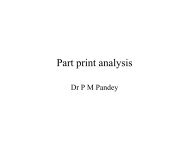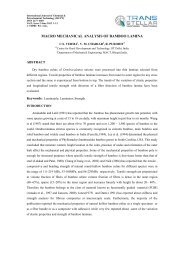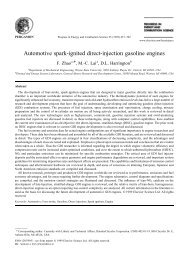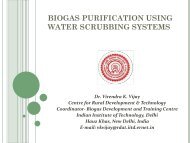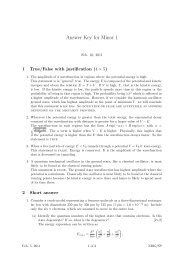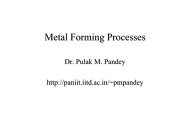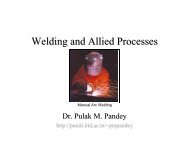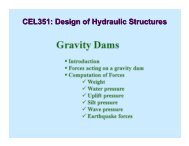1 Department of Civil Engineering-IIT Delhi CEL 212: Environmental ...
1 Department of Civil Engineering-IIT Delhi CEL 212: Environmental ...
1 Department of Civil Engineering-IIT Delhi CEL 212: Environmental ...
You also want an ePaper? Increase the reach of your titles
YUMPU automatically turns print PDFs into web optimized ePapers that Google loves.
<strong>Department</strong> <strong>of</strong> <strong>Civil</strong> <strong>Engineering</strong>-I.I.T. <strong>Delhi</strong><br />
<strong>CEL</strong> <strong>212</strong>: <strong>Environmental</strong> <strong>Engineering</strong><br />
Second Semester 2011-2012<br />
Home Work 12 Air Pollution Solution<br />
Correction:<br />
For determining velocity at height Z:<br />
[v/v0]=[z k ]/z0 where k=1/7<br />
Problems<br />
Q1. Define following terms and show figure if necessary:<br />
(i) Neutral plume<br />
(ii) Looping plume<br />
(iii) Ambient lapse rate<br />
(iv) Adiabatic lapse rate<br />
(v) Maximum pollutant concentration at ground and at source height<br />
(vi) Inversion (when surface temperature is cooler than temp. at some height)<br />
(vii) Need for calculating additional height using the Holland’s formula (i.e., plume rise)<br />
(viii) importance <strong>of</strong> wind speed and direction in determining ground level pollutant<br />
concentrations<br />
(ix) Pasquill stability classes<br />
(x) Dispersion constants<br />
Q2. Given that dry adiabatic lapse rate (Γ) = (-) 1°C/100m (in this question, this is for information and no<br />
question is being asked here)<br />
lapse rate (°C/m) atmospheric conditions plume type<br />
-0.0209<br />
(stable/unstable/neutral)<br />
unstable looping<br />
-0.0125 unstable looping<br />
-0.01 neutral coning (i.e., cone like shape about the plume<br />
line)<br />
lapse rate is negative (i.e., extremely stable air fanning (here plume spread horizontally with<br />
temp. increases with height) (inversion case)<br />
minimal vertical mixing<br />
Q3. Comment on plume types observed during early morning and late evening in summer and<br />
winter seasons.<br />
Solution:<br />
time <strong>of</strong> day season plume type<br />
early morning summer End <strong>of</strong> surface inversion (i.e., fanning) as surface temp. is becoming warmer due<br />
to Sun and thus start <strong>of</strong> unstable condition (fumigation situation as surface temp.<br />
is becoming warmer but air above is still cooler)<br />
winter End <strong>of</strong> surface inversion (i.e., fanning) as surface temp. is becoming warmer due<br />
to Sun and thus start <strong>of</strong> unstable condition (fumigation situation as surface temp.<br />
is becoming warmer but air above is still cooler) (this could delay depending on<br />
temp. during winter season)<br />
late evening summer Start <strong>of</strong> surface inversion (i.e., fanning) as surface temp. is becoming warmer<br />
and thus start <strong>of</strong> unstable condition<br />
winter Start <strong>of</strong> surface inversion (i.e., fanning) as surface temp. is becoming warmer<br />
and thus start <strong>of</strong> unstable condition<br />
1
Q4. Calculate effective stack height.<br />
physical stack height 203 m (H0)<br />
inside diameter (Dstack) 1.07m<br />
wind velocity (uwind) 3.56 m/sec<br />
air temperature (°C) 13<br />
barometric pressure (p) 1000 millibars<br />
stack gas velocity (ustack) 9.14m/sec<br />
stack gas temperature (°C) 149<br />
Hint:<br />
• Convert temp to 0 K.<br />
• Use pressure in millibars.<br />
• Use Holland’s formula for calculating plume rise (∆h).<br />
• then calculate effective height =Heff=H0+(∆h)<br />
See class notes.<br />
Q5. Plot values <strong>of</strong> Z-direction dispersion constant with stack height (Heff)=60 m, 80 m, and 120 m.<br />
Also comment on variation <strong>of</strong> σz with effective stack height.<br />
Solution:<br />
this relationship can only be obtained at ground level when y=0.<br />
As we know σz and σy depend on X(i.e., distance from source), X need to be given for solving this<br />
question. More in next assignment.<br />
Q6. A rising plume <strong>of</strong> stack gas has a temperature <strong>of</strong> 1000°C at 200m. Assuming a dry adiabatic<br />
lapse rate, determine the temperature at 1000m?<br />
Solution:<br />
Dry adiabatic lapse rate (Γ) = (-)1°C/100m (standard value for dry adiabatic lapse rate)<br />
Z0=200m and T0= 1000°C<br />
Z1=1000m and T1=?<br />
ambient lapse rate = [T1-T0]/[Z1-Z0] = Dry adiabatic lapse rate (Γ) = (-)1°C/100m (given)<br />
So<br />
[T1-1000]/[1000-200] = (-)1°C/100m<br />
T1= [-1/100*(800)]+1000<br />
T1=1000-8=992°C (answer)<br />
Case 2: What would be the temperature at 1000m if we assume wet adiabatic lapse rate (i.e., -<br />
6.8°C/Km)?<br />
4
Q7. A power plant burns 7.3 tonnes (i.e., 7.3*1000 =7300 Kg) coal per hour and discharges the<br />
combustion products through a stack <strong>of</strong> effective stack height <strong>of</strong> 75m. The coal has a sulfur content<br />
<strong>of</strong> 4.2% and the wind velocity at the top <strong>of</strong> the stack is 6 m/sec. The atmospheric conditions are<br />
moderately stable. Answer following:<br />
(i) Determine SO2 concentrations for following locations: (0,0,0); (850m, 0,0); (850m,<br />
0,75m); (850m, 0,-75m); (-850m, 0,75m); (0, 0,75m); (850m, σy, σz).<br />
(ii) Determine distance from stack at which the maximum occurs.<br />
Hint:<br />
emission rate for sulfur per hour = 7300 Kg coal/h * (purity=4.2%)=306.6 Kg Sulfur/h<br />
S+O2 SO2<br />
As 32 g sulfur gives (32+2*16=64 g/mole) sulfur dioxide.<br />
So 306.6 Kg sulfur/h would emit =594 Kg SO2/h (this is QSO2 which is used in Gaussian formula).<br />
5


